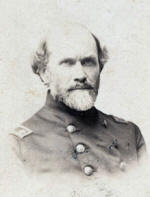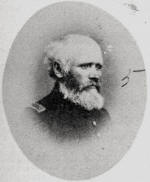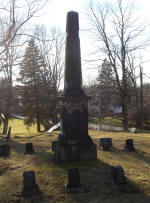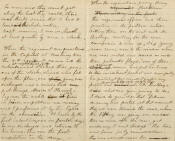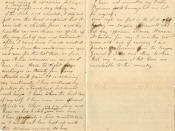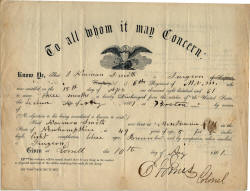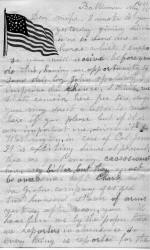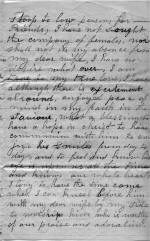c. 1861 Civil War Surgical Set by Geo. Tiemann, N.Y.
Owned by Norman Smith, M.D., Mass. 6th Volunteer Militia
Possibly the first amputation of the Civil War performed in the Rotunda of the Capital, Washington, D.C.
As sited in the Medical & Surgical History: Documents the date of the amputation and the patient. If the War began on April 12, 1861 at Fort Sumter, this operation took place on April 26, 1861 after the Riot at Baltimore and one of the first documented surgical amputation of the Civil War. "283 Herrick, M. S., Lieut., E, 8th Massachusetts. April 26, 26, '61. Surgeon. N. Smith, 6th Mass. Disch'd May 21, 1861."
This is the personal military surgical set and papers of the 6th Massachusetts Volunteer Militia surgeon Norman Smith, M.D. ,who performed one of, if not 'the' first amputations of the Civil War. Included are the papers of Dr. Norman Smith, who enter the Civil War with the 6th Massachusetts Volunteer Militia in 1861. Dr. Smith was at the first skirmish of the Civil War in Baltimore, (The Pratt Stree Riot), where a fatality occurred two weeks after the fall of Fort Sumter.
This c. 1861 Tiemann military surgical set is historically significant because it belonged to a doctor who was the attending surgeon for the troops at one of the first skirmishes (Pratt Street Riot) of the Civil War in Baltimore, Maryland. And, it is believed he performed one of the first amputations of the Civil War in the Rotunda of the Capital in Washington, D.C., which is documented in the Medical and Surgical History of the War of Rebellion.
Dr. Norman Smith, who graduated from Vermont Medical College in 1843, served as a Surgeon of the 6th Massachusetts Vol. Militia for five years before the Civil War. At the time he left for the Civil War, he was already 50 years old. His volunteer regiment was mustered into the Union Army early in 1861 and out of the Union Army after 3 months. He cared for the wounded of his regiment during and after the famous 'Pratt Street Riot' in Baltimore, April 19th, 1861 when they were attacked by southern sympathizers and the first Union troops were killed.
The Medical and Surgical History of the War of the Rebellion lists: "The following are examples of contused and lacerated wounds of the scalp produced by stones, bricks, and similar missiles: Cases.- An officer and eight men of the 6th Mass. Militia received contusions or lacerations of the scalp by paving stones, bricks, etc., on the occasion of the memorable attack upon that Regiment by insurgents in Baltimore, on April 19th, 1861: Privates G. Alexander, C. H. Chandler, and Sergeant W. H. Lamson, of Co. D.; Sergeant G. G. Durrell, Co D.; Lt James F. Rowe, of Co. L.; Privates S. Flanders, J. Porter, J. Pennell, and Charles B. Stinson, of Co. C.. These patients were conveyed, by rail, to Washington, and were treated in the E. Street Infirmary,
under the charge of Surgeon Norman Smith, 6th Mass. Vols., and the late Dr. J. Sim Smith, Assistant Surgeon, U.S.A.."See a Norman Smith biography from various History of Mass. sources.
In the documents below, the events during the first days of the War are documented and it is shown that Norman Smith, M.D. performed the first amputation of the War in the Rotunda of the Capital on one Lt. Moses Herrick after he was accidentally shot in the ankle, which required the removal of his foot by Dr. Smith. It is assumed Smith would have used this surgical set to do the amputation since it was his personal militia set which he would have brought with him from Mass. when he traveled to Washington, D.C. by train.
Citation from the Medical and Surgical History, Part III, Volume II
Chapter X.--Wounds And Injuries Of The Lower Extremities.
Section V.--Wounds And Operations In The Leg.
Fatal Primary Amputations in the Lower Third of the LegPage: 283 Herrick, M. S., Lieut., E, 8th Massachusetts. April 26, 26, '61. Right. Surg. N. Smith, 6th Mass. Disch'd May 21, 1861.
(Extensive provenance details are presented here to illustrate how surgical sets are dated and analyzed, then related to historical information about an owner or surgeon. This is also a fine example of a state volunteer militia military surgical set.)
The Tiemann surgery set is unique in several ways. It has the early trade label with the 63 Chatham St. address, placing the maker time frame prior to and during the first year of the Civil War. The mahogany case's brass cartouche is not engraved and has never been removed from the case or reversed (examined by x-ray), and there are no military markings on the instruments, which would have indicated a Federal goverment military issue. The case does have military style sliding latches, which anyone could have ordered from Tiemann. Ordinarily, the lack of U. S. Army markings would be unusual, but it is believed this set was purchased by Dr. Smith while in the Mass. Vol. Militia (5 years prior to the Civil War), or in anticipation of his being mustered into the Union Army and he took it with him to and from the service. A Federal government military issued set would not have been taken with the surgeon if he left the service due to the shortage of surgical sets or instruments during the early part of the War. Smith was in the Union service for three months as part of the 6th Mass. Vol. Militia and then was discharged with the rest of his Militia regiment when the Union Army reformed his regiment. His dated discharge paperwork is part of this collection and is shown below. The document is signed by Col. Jones, who later became a governor of New York.
The 6th Mass. militia was an a old colonial entity and part of the state, not the Federal Army. The reason the set isn't marked as Federal military issue is because Smith would have bought it to use in the Mass. Old 6th militia (a remnant of the 1776 militia in Mass.,) and then carried it to and from his service in the Mass. 6th Infantry regiment when it was formed as part of the Union Army. The Old 6th was only (assigned) in the Union Army for three months before it was re-organized as a different regiment under the Union Army and so the Union had to officially discharge all the Old militia, thus the discharge paperwork for Smith. Due to Smith's advanced age and medical problems, it is unlikely he would have continued in the Army.
If Smith wanted to buy a Tiemann amputation set during the 5 years he was in the 6th Militia, this set is the exact one that would have been available from Tiemann in that time frame. Tiemann and other makers provided military style sets to the U.S.A. Medical Department before and during the Civil War. If Smith was going to order or buy an existing set during the time window of his being a surgeon in the 6th Militia, he would have ordered or bought one with military latches to use in the field. (Keyed locks being unnecessary during war-time use) After 1861, the sets and instruments for a Civil War era set would have been totally different from this set. The five years before Smith was mustered into the Union Army and the five years during which Tiemann produced the 'D' handled capital saw totally match. What are the odds today of anyone finding an unmarked amputation set with military latches that would fall in the years during which Smith could have bought this set? Zero and none.
The set contains the basic amputation instruments, marked with the old English font '
TIEMANN' inscription, but as mentioned, there is no reference to the U. S. Army Medical or Hospital Dept. and this fact is significant to relating the set to Dr. Smith. Since this kind of set would have been bought by an individual from the New York Tiemann company prior to the War the lack of markings is not unusual. If it had been purchased by the government for government use or issue it would most likely be marked 'U.S. Army Medical Dept. prior to the war. So, that explains how Dr. Smith left the service with his own set.The presence of the 'D' handle style capital saw is telling because this style saw was only sold by Tiemann from about 1855 to 1861. This type of small saw was not specified or produced later in the War for the Union Army. This set would not have been used as a contract production set made by Tiemann and used during the War. It is a set bought by an individual during a narrow time frame, for use as a field set during battle.
For comparison, look at the following sets:
1850's Tiemann Ivory surgical set with a "D" type saw handle that preceded the later 1860 version without vertical slots in the blade.
1855 compared to an 1861 Tiemann surgical set with the same "D" type saw handle in a set with more extensive instruments.
Two interrelated facts are important here to connect this set to Smith: first, the narrowly defined dates when the Tiemann set was made and the details supporting the fact that it was not government issue or owned. Second, the dates when Smith was in the 6th Mass. Militia and would have procured a surgical set for his use in the Militia, then taking the set to Washington with him during the first days of the War. It is especially important that this is not a U. S. A. Medical Department owned set since Smith would not have been able to take the set home with him when he left the army. It was his set as a member of the Mass. militia and he took it with him when he left the service.
The answer again to the question about why the set is not Army marked is as follows: Smith could have special ordered and purchased the Tiemann surgery set before his Mass. Vol. militia regiment was mustered (assigned) into the Union Army in 1861. The presence of the sliding military latches indicates Smith intended to use the set in the field while in the Militia. The reason for the sliding latches being one did not want to have to keep up with a key under military conditions and Tiemann had experience making sets for the Army Medical Department prior to the War, so Smith would have drawn on that experience in buying a military style set. The dates of the location on the Tiemann trade label as well as the configuration of the saw and other instruments narrow the time frame to immediately before the War during the time Smith was in the Militia and before his unit was mustered into the Union Army.
The odds of the Smith documents, him being in the Militia, and the time frame of the set production being 'put-together' by someone to commit fraud are extremely unlikely and infinitesimally remote. Finding a set with the parameters present in this set would be impossible to find and to correlate with Dr. Smith's time line or his history. The history of Smith and the unique features of this set are just too unique for anyone to have put together with the intent to defraud. The source of this paperwork and set were from an antique dealer who had no knowledge of any of the information I have spelled out on this page. There are maybe five people in the world who would have had the knowledge to assemble this confluence of set and paperwork. Finding a set to match the history of Smith...impossible~!
Norman Smith, M.D. Surgeon (age 50's) in uniform , his grave site, an earlier CDV, and his signature
Above photos courtesy of Larry DeCan, Eleanor Gavazzi collection
Additional information on Dr. Norman Smith in his uniform
Above is a selection of some of the Smith signed paperwork accompanying this set. In the letters Smith wrote (in 1885) to an author who was writing a history of the War, describing an amputation Dr. Smith performed in the Rotunda after a mini ball accidentally struck the ankle of a solder by the name of Lt. Moses Herrick in the Rotunda of the Capital in Washington during the opening days of the War.
Above, Smith's discharge document dated 1861, mustering him out of the Union Army. It is signed by Col. Jones, who later became the governor of New York. Smith was in his 50's at this time.
The letter from Dr. Smith below is from Baltimore, May 15, 1861, describing events the day of the Pratt Street Raid, which is the first skirmish of the War after the assault on Ft. Sumter and accounted for the first fatalities of the War.
The cartouche' is not marked, has never been removed ,and there are military latches. Military latches could have been ordered from Tiemann by anyone, but would most likely have been ordered for the Mass. 6th Vol. militia by Smith.
Engraving of the cartouche' would have been performed for 'U. S. Army Medical Dept.' ordered sets and this set is not engraved on the top surface..
This capital saw is very small, typical of c. 1860-1. Also shown is a tiny finger saw. This is not the kind of instruments that would have been ordered by the Medical Dept. for use in the field. The instruments are too light in construction for field use by the army. But, the saw and light amputation knives were the style being produced by Tiemann post 1850 and just prior to the Civil War.
The tourniquet is marked with the early font for Tiemann and is the smaller version as compared to earlier tourniquets by Tiemann. Note the strap is not red nor does it have the stripes associated with later tourniquet straps during the War. The buckle is typical of the Civil War era with the blued iron prongs.
Bone forceps in new condition, marked with the early Tiemann font, cross-hatched handles typical of earlier instruments, without the blued spring between the handles of later forceps
Note the various markings on the knives. Only one has the later version of Tiemann, typical of the Civil War period.
This photo shows the long slim blades of the amputation knives, so typical of the 1850-61 period at Tiemann. All the later knives during the War are much heavier as were those blades and handles which preceded this short period right before the Civil War.
This is the first instance of a wire pin retained trephine shaft I've seen. I've also never seen a trephine shaft marked 'Tiemann'. Note the tip of the handle has a pull wire which moved in and out through the middle of the handle to retain the tip of the brass shaft. There is no threaded retaining screw to hold the handle on the brass shaft as normal. There is a brass key on the top of the shaft to prevent rotation and to align the hole in the shaft for the sliding wire pin in the handle interior. Further evidence of this being a unique set with limited production instruments.
The crown of both trephines are the earlier non-tapered edge-cutting version
Note the upper left and center/right fonts for 'Tiemann', this mix is found frequently in the Civil War period
Bone wax to stop bleeding of cut bone, suture needles and silk thread
See article on suturing and suture needles
Documentation of the amputation performed by Norman Smith, M.D. in Washington, D.C. after the Baltimore Riot
